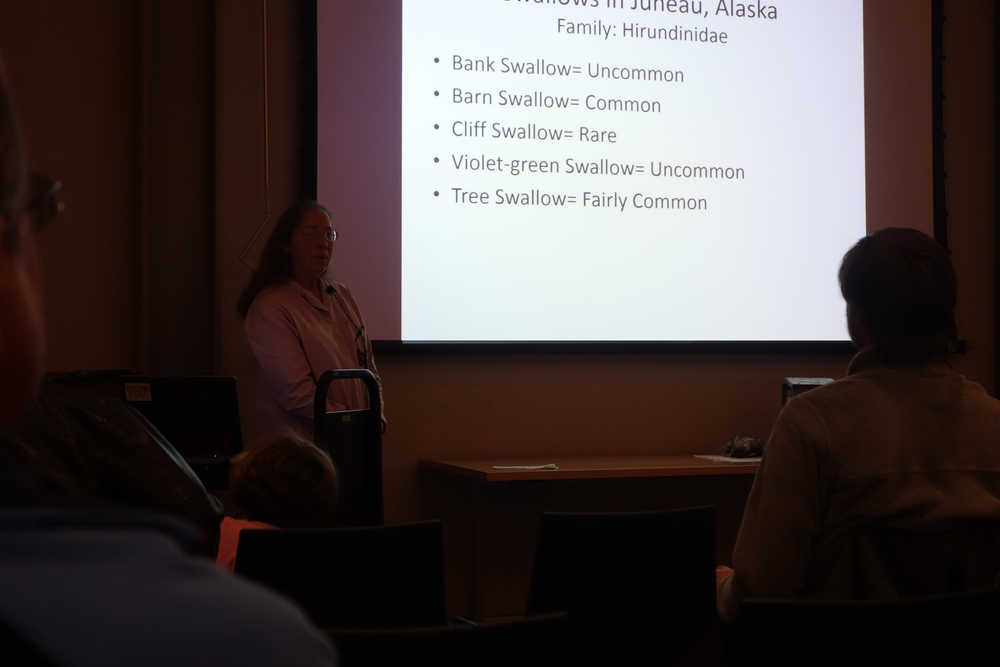At a crowded Mendenhall Valley Public Library, people gathered for a Wildlife Wednesday hosted by the Southeast chapter of the Alaska Wildlife Alliance to hear naturalist Brenda Wright of the Juneau Audubon Society answer the question frequently asked of her: where have the tree swallows gone?
“Even though I’ve lived here a long time — over 30 years now — I never got to enjoy something like this,” Wright said as she indicated a screen display of a flock of tree swallows taking flight. “If that’s what (people) tell me they used to have here, where did all the swallows go?”
The short answer, she said, was we don’t know exactly why since there haven’t been enough studies done. She does have her suspicions on possible culprits, such as the herbicides and pesticides that have also affected the decline of honeybee populations. Swallows molt during migration, Wright explained. When they’re coming north, they have to have a good feeding habitat for weeks at a time since they molt and have to produce more feathers. It takes them about three months to go from Baja, California, to Juneau, she said, so swallows are extremely vulnerable to climate change and food scarcity.
Wright does know the answer is not as simple as tree swallows nesting somewhere else. The population has been declining all over North America, by 49 percent in 20 years, she told the audience. The biggest decline has been in the Northeast of the U.S.
“There’s lots of studies going and there’s lots of possibilities,” she said in the Northeast, looking at things like habitat loss, climate change and pesticides. Outside of this area, studies are sparse.
Wright decided to help gather information on population levels with the help of other volunteers, funded through a grant from the Alaska Audubon Society.
“I knew from the beginning that there had been a project here in 2005,” she said, which was for the environmental impact statement for the expansion of the Juneau airport, done by the U.S. Fish and Wildlife Service. Tree swallows are cavity dwellers, but they do not excavate their own cavities, so they will nest in human-made boxes with little hesitation. The project made 50 wooden birdhouses designed specifically for tree swallows and placed them in five different locations around Juneau. After some of the birds arrived, some were banded; researchers found some of the banded birds do return to Juneau.
“It became the inspiration for our present project,” Wright said of the Juneau Audubon Society. “Our project was to build some more boxes.”
The boxes from the original study eventually fell into disrepair. With the help of Juneau Youth Services, Wright and the Juneau Audubon Society put together and placed new boxes for the swallows for observation in tree swallow habitats.
On these numbered boxes, a little sign was placed on each explaining the purpose of the boxes and how bird watchers can share their observations on a standardized data form.
“Citizen science is the key,” Wright said. “We wanted to collect data locally, which could be used nationally. The only way we could do that was create a set of rules that help us collect data that is useful in a national database. The only way to do that is add local data to the big picture.”
For the 2015 season, the team put the boxes up in mid-May; swallows come to Juneau in mid-April, which didn’t give Wright and her team a good look at the birds since they try to make a nest as soon as possible after arrival.
However, the first season the team set up the boxes gave them insight on what to do better next year.
For 2016, the group got the boxes up by April 15, in time for the swallows’ arrival; some of the sites changed based on activity observed in 2015, but some remained the same, like at Kingfisher Pond. The first reported sighting of a swallow happened on April 18. The last swallows observed were in July.
At the end of the season, the team took down the birdhouses, opened them, and recorded what they found. Out of 40 boxes, there were 15 nests, four unhatched eggs, two dead hatchlings, three partially completed but unused nests, and one dead adult tree swallow. One box was ripped open by a bear that had probably been attracted to the noise of the fledglings, Wright said.
“We’re going to repair the boxes as needed, especially the ones chewed open,” Wright said of 2017 plans. The goal this year is to have all of them set up by April 1.
She said they could use more volunteers for repairing and placing boxes, as well as bird observation.
In the future, Wright said she’d like to band the birds for more data, but because qualified bird-banders are limited in Juneau, there are no plans to do it currently.
Wright can be reached through the Juneau Audubon Society at juneau-audubon-society.org/officers.htm.
• Contact reporter Clara Miller at clara.miller@morris.com.

